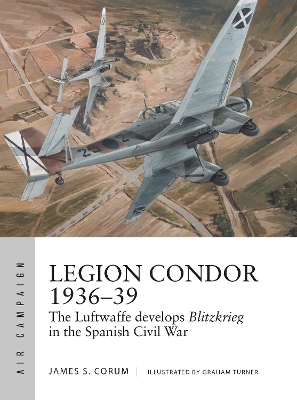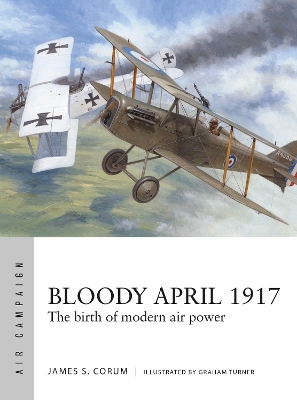Air Campaign
1 primary work • 3 total works
Book 16
The bombing of Guernica has become a symbol of Nazi involvement in the Spanish Civil War, but the extent of the German commitment is often underestimated. The Luftwaffe sent 20,000 officers and men to Spain from 1936 to 1939, and the Condor Legion carried out many missions in support of the Spanish Nationalist forces and played a lead role in many key campaigns of the war. Aircraft that would play a significant role in the combat operations of World War II (the Heinkel 11 bomber, the Me 109 fighter, and others) saw their first action in Spain, fighting against the modern Soviet fighters and bombers that equipped the Republican Air Force. Condor Legion bombers attacked Republican logistics and transport behind the lines as well as bombing strategic targets, German bombers and fighters provided highly effective close air support for the front-line troops, and German fighters and anti-aircraft units ensured Nationalist control of the air.
The experience garnered in Spain was very important to the development of the Luftwaffe. The war allowed them to hone and develop their tactics, train their officers, and to become the most practised air force in the world at conducting close support of ground troops. In effect, the Spanish Civil War proved to be the training ground for the Blitzkrieg which would be unleashed across Europe in the years that followed. In this rigorous new analysis, Legion Condor expert James Corum explores both the history and impact of the Luftwaffe's engagement during the Spanish Civil War and the role that engagement played in the development of the Luftwaffe strategy which would be used to such devastating effect in the years that followed.
The experience garnered in Spain was very important to the development of the Luftwaffe. The war allowed them to hone and develop their tactics, train their officers, and to become the most practised air force in the world at conducting close support of ground troops. In effect, the Spanish Civil War proved to be the training ground for the Blitzkrieg which would be unleashed across Europe in the years that followed. In this rigorous new analysis, Legion Condor expert James Corum explores both the history and impact of the Luftwaffe's engagement during the Spanish Civil War and the role that engagement played in the development of the Luftwaffe strategy which would be used to such devastating effect in the years that followed.
The German invasion of Norway was a pivotal moment in modern warfare, the first joint campaign that featured air power as an equal element of all operations. It was, in fact, the superior use of their air force that gave the Germans the decisive margin of victory and ensured the failure of the Allied counter-offensive in central Norway in April and May 1940.
All aspects of air power were employed in Norway, from long-range bombing and reconnaissance to air transport, with the Luftwaffe’s ability to transport large numbers of troops and supply ground forces over great distances being particularly important. Norway was the first campaign in history in which key targets were seized by airborne forces, and the first in which air superiority was able to overcome the overwhelming naval superiority of an enemy.
Researched from primary sources, this engaging history by air power expert Dr James Corum skilfully draws out where and why air power made the difference in Norway, and analyses the campaign’s influence on the coming months and years of World War II.
All aspects of air power were employed in Norway, from long-range bombing and reconnaissance to air transport, with the Luftwaffe’s ability to transport large numbers of troops and supply ground forces over great distances being particularly important. Norway was the first campaign in history in which key targets were seized by airborne forces, and the first in which air superiority was able to overcome the overwhelming naval superiority of an enemy.
Researched from primary sources, this engaging history by air power expert Dr James Corum skilfully draws out where and why air power made the difference in Norway, and analyses the campaign’s influence on the coming months and years of World War II.
Researched from original-language primary sources, this is a uniquely well-informed and multi-faceted history of the World War I air campaign of Bloody April.
Researched from original German-, French-, and English-language sources, and written by an authority on both air and ground military operations, author, Dr James S Corum examines how Bloody April caused Allied forces to reassess their approach to the use of airpower. Considering well-known problems such as technology and training doctrine, but also how the artillery-aircraft combination ideally had to work in late-WW I ground offensives, Dr Corum analyses what each side got wrong and why. He describes little-known parts of the April campaigns, such as both sides' use of strategic bombing with heavy aircraft, and considers the German use of advanced high-altitude reconnaissance aircraft with oxygen and heated suits while detailing the exploits of the infamous 'Red Baron', Manfred von Richthofen.
Lessons from Bloody April not only served to improve the coordination of Allied artillery and aircraft but subsequently aircraft played a much larger role in supporting ground troops in attack mode.
Bloody April paved the way for the airpower revolution that, by 1918, would make the Allies masters of the sky on the Western Front.
Researched from original German-, French-, and English-language sources, and written by an authority on both air and ground military operations, author, Dr James S Corum examines how Bloody April caused Allied forces to reassess their approach to the use of airpower. Considering well-known problems such as technology and training doctrine, but also how the artillery-aircraft combination ideally had to work in late-WW I ground offensives, Dr Corum analyses what each side got wrong and why. He describes little-known parts of the April campaigns, such as both sides' use of strategic bombing with heavy aircraft, and considers the German use of advanced high-altitude reconnaissance aircraft with oxygen and heated suits while detailing the exploits of the infamous 'Red Baron', Manfred von Richthofen.
Lessons from Bloody April not only served to improve the coordination of Allied artillery and aircraft but subsequently aircraft played a much larger role in supporting ground troops in attack mode.
Bloody April paved the way for the airpower revolution that, by 1918, would make the Allies masters of the sky on the Western Front.


